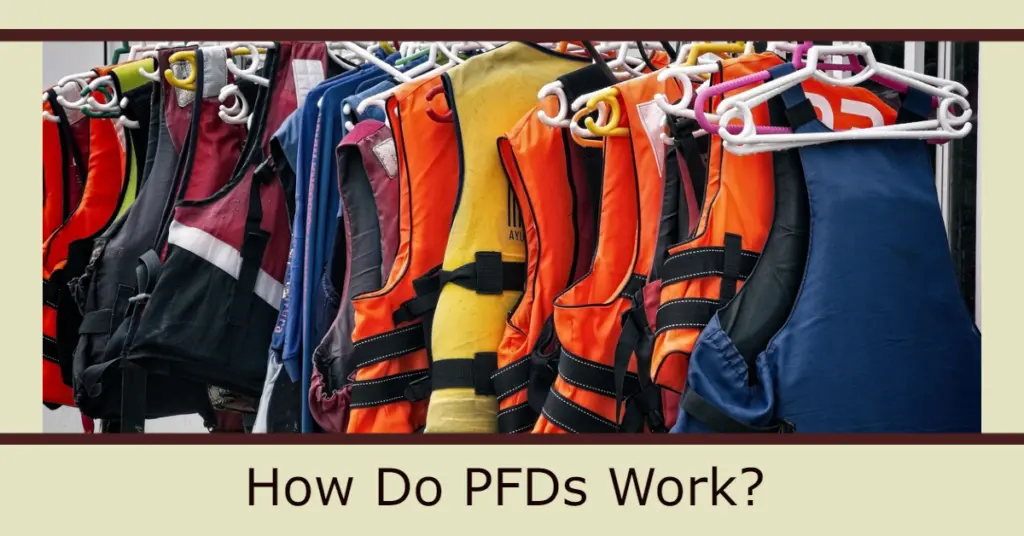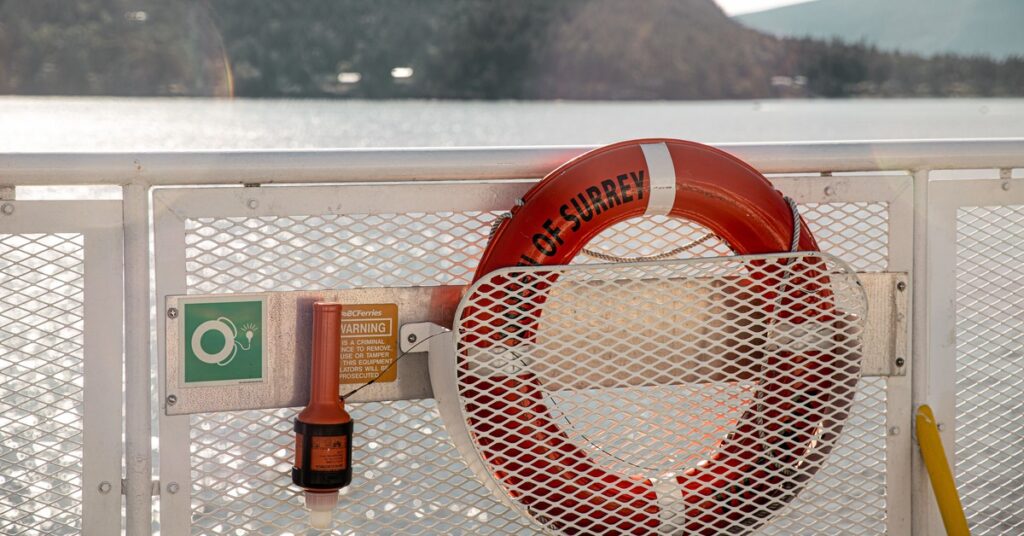Personal floatation devices (PFDs) are necessary when people are near deep water. While no one hopes for a water-related emergency, PFDs can be the difference between life and death. Life vests or ring buoys are common around beaches and boats, but what is the meaning of PFDs and the science behind them?

Understanding Buoyancy
When someone gets into a body of water, the water rises around them thanks to the force pressing against gravity. The upward pressure is called buoyancy. It displaces weight when something enters a pool and acts on any object that weighs as much as the water. Whether it’s a pebble or a person, anything that enters a body of water has some form of buoyancy. The top of the object faces less pressure than the bottom.
PFDs rely on buoyancy to keep people afloat in an emergency. Adults need at least 7-12 pounds for their heads to remain above water.
Archimedes’ Principle
PFDs weren’t introduced until the late 1800s. However, science planted the seeds for their creation long before the first device.
In 212 B.C., Archimedes of Syracuse discovered that objects partially or fully placed in liquid face a force equal to the weight of the displaced fluid. Almost as famous as the principle itself is how Archimedes discovered it. The story goes that he was taking a bath when it came to him, and he immediately ran out of the tub and into the streets to tell the king. As he traveled, he shouted, “Eureka!”
The volume of displaced liquid or gas is the same for an underwater object. For floating objects, the weight is the same. The concept became Archimedes’ Principle or Fb = ρgV.
Archimedes didn’t cover surface tension. However, it only multiplies the fluid, not the object itself, so the principle remains valid. Items with more volume have more buoyancy regardless of the surface pressure. That effect is upthrust.
History of PFDs
The first known flotation devices were hollow gourds and inflated animal bladders, used to cross deep streams and rivers. Norwegian seamen experimented with wood and cork for the same purpose.
The First Preserver
Dr. Francis Daniel created an inflatable life preserver from leather in 1806. Daniel proved its effectiveness by having a celebration where several men jumped into the Thames with the devices. During their float downstream, they smoked, drank, played musical instruments and shot off guns. A hundred years later, Gustave Trouvé created a cork preserver that used rubber-insulated batteries to inflate the jacket, turn on a light and launch a distress flare.
World War II
During World War II, the ideal material for maritime life preservers changed from cork to kapok cells. The new material gave soldiers more flexibility to fight while preventing drownings. Inflated vests are not consistently buoyant but kapok is, so inflation wasn’t distracting for the Navy.
While the war was ongoing, Professor Edgar Pask devised an alternative solution. He researched anesthesia and proposed that soldiers could self-administer it to avoid hypothermia if they fell into the sea. It doesn’t take much work to keep body systems running when someone is unconscious, letting the brain focus on keeping warm. Pask bravely experimented on himself. He anesthetized and paralyzed himself and then hyperventilated to simulate the scenario airmen might face when shot into the ocean.
However, there were significant drawbacks to implementing this plan. During his experiments, Pask suffered health problems that lasted the rest of his life. However, his scientific advancements earned him a Most Excellent Order of the British Empire (OBE) membership. He became known as one of the bravest men working for the Royal Air Force who didn’t fly in the war.
Instead of anesthesia, British sailors used inflatable life rings during the early war that gave them about 8.5 pounds of buoyancy. However, it didn’t have enough power to keep their heads above water.
U.S. infantry received the M1926 life preserver belt when going on a ship or being near water, including on D-Day. The belts operated with carbon dioxide bottles that soldiers could use to inflate the devices. A tube also allowed them to inflate them manually if the bottles failed.
The Royal Air Force and U.S. Army Air Forces used inflatable preservers that they nicknamed Mae West since they thought the devices looked like the actress’s breasts. Peter Markus developed the patented design in 1928 and continuously made improvements.
Modern PFDs
Today’s floatation devices typically use polyester or nylon with thermoplastic polyurethane (TPU). There are different sizes and shapes to accommodate various body types. Life jackets have adjustable straps and other customization options to keep people safe in the water.
Military, government and commercial officials generally have different types of devices depending on the most likely water scenarios. Soldiers’ vests often have compatibility with other wearable equipment like body armor and repelling harnesses.
Identifying the Right PFD
A swimmer or sailor can identify the type of PFD they need by evaluating the different categories of modern devices.
- Type I: These are meant for exposure to deep, rough waters. Type one is for offshore activities. When someone is unconscious, these PFDs will turn them face up to prevent drowning. These are life jackets and vests in the literal sense.
- Type II: These are slightly less buoyant than Type I but will still keep people in a face-up position. Instead of the traditional jacket shape, they go over the neck.
- Type III: Type three is for inshore use only, when land is visible from the water. They fit like a vest but will not keep someone facing upward. They’re good for dock workers who could slip into the water but are unlikely to go long without rescue.
- Type IV: Instead of a wearable device, these throwable options tow people in and keep them afloat until someone reaches them.
- Type V: These PFDs are specifically designed for a purpose. They aren’t on store shelves and require customization.
Type I foam-filled wearables require a minimum 22 pounds of buoyancy, while Type II and Type III only need 15.5. Inflatable options have a higher requirement of 33.7 pounds for Type I and 22.5 pounds for Types II and III, while Type IV devices have a minimum buoyancy of 16.5 pounds. All PFDs should get two checks a year to ensure proper buoyancy.

What Are Personal Floatation Devices?
PFDs help individuals stay afloat in the water. There are many different versions for commercial and military purposes.
Commercial
Most commercial PFDs are the lifejackets seen or worn on sea voyages. They’re intended for use on inspected and uninspected watercraft and often combine floatable materials and inflatable air pockets.
There are many reasons life jackets are one of the essential emergency preparedness tools available whenever there is deep water. Even the best swimmers tire eventually from muscle exhaustion and hypothermia. These devices keep their bodies above water, making them one of the primary pieces of personal protective equipment rescue teams carry. While falling off a boat would hopefully result in a quick recovery, it’s not guaranteed. Someone might get injured or be disoriented, making it vital to wear a lifejacket even briefly.
One of the best chances for survival if a plane crashes over an ocean is to put on the life jacket the carrier provides. It’s always a good idea for passengers to ensure their life jackets are properly positioned. Airplane seats also double as another PFD.
Life jackets are also necessary on cruise ships, especially since people may fall from a lifeboat. After the sinking of the Titanic in 1912, the International Convention for the Safety of Life at Sea set regulations for having a PFD for every passenger aboard a commercial vessel.
Recreational
Recreational PFDs are for uninspected commercial vessels under 40 feet and personal boats. These life jackets and other inflatable or buoyant devices can be found in sporting supply shops and big-box hunting and fishing sections. Customers can often rent them. Some rescue squadrons will hold events that give out free life jackets.
Not having a PFD is a safety risk that some authorities will fine people for or prevent them from going out on the water.
Fisherman Paul Reed fell out of his boat in September 2021. He credits his life jacket and its accompanying locator for saving his life. The water was only 60 F, which is dangerous to spend extended time in. Thanks to the jacket, the Coast Guard was able to find him safely in just over an hour. In an interview afterward, Reed told fellow fishermen to “Wear a lifejacket. I did, and it saved my life.”
Throwable
Non-lifejacket PFDs can help rescue people out at sea. Visitors will commonly see these with lifeguards on beaches that don’t require civilians to have PFDs in the ocean. Someone in crisis can grab onto one of these items to increase their buoyancy until they get ashore. The devices include:
- Ring buoys
- Rescue tubes
- Rescue cans
- Throwable cushions
Research from the United States Lifesaving Association found that the chance of drowning on a beach is one in 18 million with a trained lifeguard.
Pet Life Jackets
Some companies sell PFDs for domestic animals, like dogs and cats. Many owners like to bring their furry friends to the beach and on adventures, but around 5,000 dogs drown each year due to poor swimming skills, exhaustion or medical complications. Life jackets can prevent unnecessary deaths.
Most of these are life jackets that owners can strap around them. Follow the manufacturer’s recommendations, as some aren’t suitable for heavier dogs.
Remember that most animal PFDs are passive, meaning people must pre-inflate them. It’s best to place it on them before taking them near the water.
Frequently Asked Questions
How Do PFDs Stay Afloat?
PFDs use the scientific principle of buoyancy. Certain materials and inflation designs offer enough of it to keep people afloat. Adults need a minimum of 7-12 pounds of buoyancy.
Who Discovered PFDs?
Though many primitive versions existed, the first popularized PFD came from Dr. Francis Daniel in the early 1800s. The most advancement in these devices occurred during World War II.
Are There PFD Regulations?
Laws about PFDs vary depending on location. However, regulations for cruise ships and other commercial vessels stem from the Titanic tragedy.
Which Type of PFDs Should People Wear?
There are five categories of PFDs depending on the situation. Type I is for offshore activities, Type III is for shoreside activities and Type IV is customized for individual cases.
- The Push to Reduce Cruise Ship Carbon Emissions in 2024 – July 19, 2024
- Marine Satellite Internet: How Ships Keep Connected – July 10, 2024
- What to Wear on a Boat – June 24, 2024




Leave a Reply